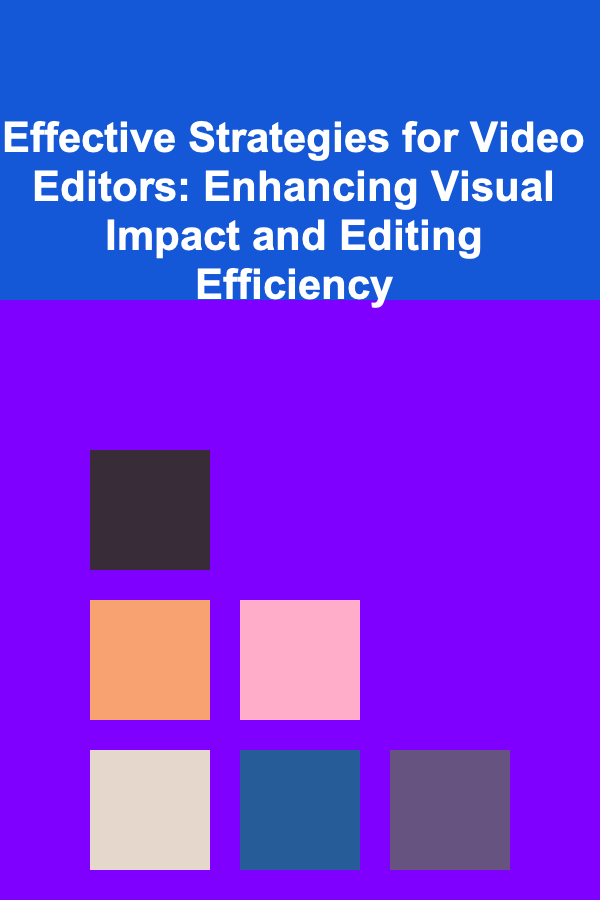
Effective Strategies for Video Editors: Enhancing Visual Impact and Editing Efficiency
ebook include PDF & Audio bundle (Micro Guide)
$12.99$9.99
Limited Time Offer! Order within the next:

Video editing is both an art and a science. In the world of modern digital content, creating captivating, high-quality videos requires not just technical skill, but a deep understanding of the creative process. Whether you're working on a cinematic masterpiece, a YouTube vlog, or a corporate video, effective editing is key to delivering a powerful message and engaging the audience. This guide explores strategies for video editors to enhance both the visual impact of their videos and their editing efficiency, ensuring that the final product is both polished and produced in a time-efficient manner.
Master the Fundamentals of Editing Software
Before diving into advanced techniques, mastering the editing software is essential. No matter how creative or talented an editor is, it's the software that will bring their vision to life. Common editing platforms like Adobe Premiere Pro, Final Cut Pro, and DaVinci Resolve come with a plethora of tools, and getting comfortable with them will vastly improve editing efficiency and output quality.
Actionable Tips:
- Learn Keyboard Shortcuts: One of the quickest ways to boost editing efficiency is by learning the keyboard shortcuts for your chosen software. Navigating menus and tools can slow you down, but with shortcuts, tasks like trimming, cutting, or adding transitions can be done in seconds.
- Create Custom Workspaces: Customize the workspace layout to fit your workflow. By arranging panels (timeline, effects, program monitor) in a way that suits your preferences, you can minimize distractions and enhance your productivity.
- Use Proxy Files for Heavy Footage: If you're working with high-resolution footage, use proxies (lower-resolution copies) during the editing process. This will make the timeline smoother and the rendering faster, especially when dealing with 4K or 8K video.
Establish a Clear Vision Before You Begin
Effective editing begins before you even start cutting clips. Having a clear vision of the video's final look and feel is essential for ensuring consistency and making strategic decisions throughout the editing process.
Actionable Tips:
- Create a Moodboard or Visual References: Develop a moodboard that captures the tone, color palette, and style of the video. Visual references such as other videos or imagery that inspire you can guide your editing choices.
- Define the Story Structure: Whether it's a short video or a full-length feature, knowing the beginning, middle, and end of your story will help you stay focused. Map out key moments you want to highlight and determine which visuals best tell that story.
- Choose the Right Editing Style: The editing style should complement the message of the video. Fast-paced, jump cuts work well for energetic and youthful content, while smooth transitions and slow motion are better for emotional, cinematic projects.
Focus on Visual Composition and Framing
The way a video is composed plays a huge role in the overall visual impact. Editors often work with footage that was shot with specific camera angles, but it's their job to enhance or adjust these shots to create a more compelling visual experience.
Actionable Tips:
- Cut on Action: One of the most effective ways to create seamless transitions between shots is to "cut on action." This means cutting from one shot to another when there's movement, which helps the edit flow more naturally and maintains the rhythm of the scene.
- Pay Attention to Rule of Thirds: The rule of thirds is a fundamental principle of visual composition. When editing, always consider how your shots are framed. Placing important elements off-center can create a more dynamic and visually interesting scene.
- Use Color Grading for Impact: Color grading allows you to change the mood of your video entirely. Use warmer tones for a cozy or nostalgic feel, or cooler tones for a more dramatic, serious atmosphere. Consistency in color grading throughout the video ensures visual cohesion.
Enhance Storytelling Through Pacing and Rhythm
Pacing is the tempo at which a video unfolds. Proper pacing can make the difference between a video that feels sluggish or one that maintains the audience's attention from start to finish.
Actionable Tips:
- Vary the Pace Based on the Scene: A high-energy scene should move quickly, with short cuts and quick transitions. In contrast, a slower scene may benefit from longer shots to allow the viewer to absorb the emotion or details.
- Use Sound to Guide Pacing: Sound design plays a crucial role in pacing. For example, adding background music or sound effects can heighten a scene's energy, while a sudden silence can create tension. Syncing the rhythm of your cuts with the beat of the music enhances the overall pacing.
- Trim Unnecessary Footage: Don't be afraid to cut out excess footage. If a shot doesn't contribute to the story or drag on too long, trimming it can improve the pacing and ensure that the video stays engaging.
Maximize the Power of Transitions
Transitions are more than just ways to move from one scene to another---they're an essential storytelling tool. Whether you're using hard cuts, fades, or creative effects, transitions can help establish mood and context.
Actionable Tips:
- Use Transitions to Signal Time or Change: For example, a dissolve can imply the passage of time, while a quick cut or whip pan might signal a dramatic change in the scene or mood. Choose transitions that make sense for the story.
- Don't Overuse Effects: While it can be tempting to use flashy transitions, remember that simplicity is often more effective. Subtlety can be just as powerful as elaborate effects when used at the right moment.
- Match Transitions to the Audio: Just as with pacing, transitions often work best when synced with audio. A visual transition, such as a fade-out, can be enhanced by corresponding sound design, such as a fading ambient sound or a musical cue.
Integrate Text and Graphics Creatively
Text and graphics are essential for conveying information and enhancing the visual storytelling process. However, their overuse or misuse can distract from the message. The key is to integrate them seamlessly with the video content.
Actionable Tips:
- Keep Text Clear and Concise: Use text sparingly, ensuring that it adds to the video without overwhelming it. Choose legible fonts, and ensure that text appears long enough for viewers to read.
- Animate Graphics to Add Movement: Subtle animations can make text and graphics feel more dynamic and integrated into the video. For instance, animating lower-thirds, titles, or callouts adds polish without being too flashy.
- Use Color to Tie Graphics to the Overall Aesthetic: Ensure that any text, titles, or graphic elements follow the color scheme you've set for the video. This helps create a cohesive, professional-looking video.
Optimize for Different Platforms
Once your video is edited, the next challenge is optimizing it for various platforms. Whether it's YouTube, Instagram, or a corporate website, each platform has different requirements for video formats, resolutions, and aspect ratios.
Actionable Tips:
- Export for Each Platform's Requirements: Platforms like YouTube typically work best with 16:9 aspect ratio and HD resolutions, while Instagram prefers square (1:1) or vertical (9:16) videos. Ensure that you're exporting the right format for each specific platform.
- Use Thumbnails and Titles to Increase Engagement: A strong thumbnail and an engaging title are essential for attracting viewers. Create thumbnails that are visually compelling and clearly communicate what the video is about.
- Keep Audience Behavior in Mind: For social media, where user attention spans are shorter, try to hook viewers in the first few seconds with captivating visuals, text, or sound. For longer videos, like those on YouTube, make sure your pacing keeps the audience engaged throughout.
Maintain a Consistent Workflow
Efficient editing is as much about managing time and resources as it is about the creative process. An organized workflow can significantly speed up your editing process without sacrificing quality.
Actionable Tips:
- Organize Your Files Properly: Keep your footage, audio files, and assets organized in clearly labeled folders. This will save you time when searching for specific clips or sounds during the editing process.
- Use a Version Control System: Regularly save versions of your project to prevent losing important edits and allow for easy reversion if needed.
- Break the Project into Manageable Sections: Long projects can be overwhelming. Break them into smaller, more manageable segments to focus your attention and make steady progress.
Conclusion
Video editing is an intricate process that requires technical skills, creativity, and an understanding of how different elements come together to create a cohesive final product. By mastering the fundamentals, having a clear vision from the start, focusing on pacing, composition, and storytelling, and optimizing for various platforms, editors can significantly enhance both the visual impact of their work and their overall editing efficiency. With consistent practice and a strategic approach, any editor can produce engaging and high-quality videos that resonate with their audience.
Reading More From Our Other Websites
- [Home Cleaning 101] How to Clean a Microwave: Tricks for a Streak-Free Interior
- [Home Space Saving 101] How to Double Your Pantry Space with Smart Small Kitchen Storage Ideas
- [Stamp Making Tip 101] Best Stamp Making Materials: A Detailed Guide for Professional Results
- [Biking 101] The Best Women's Bikes for Comfort and Performance in 2025
- [Paragliding Tip 101] Best Paragliding Photography Techniques: Capturing Stunning Aerial Shots and Drone Integration
- [Polymer Clay Modeling Tip 101] Best Workflow for Batch‑Producing Polymer Clay Charms with Consistent Quality
- [Digital Decluttering Tip 101] Proven Strategies for Efficient Digital Document Management
- [Screen Printing Tip 101] Common Mistakes in Glass Screen Printing---and How to Avoid Them
- [Organization Tip 101] How to Keep Your Exercise Space Clutter-Free
- [Personal Investment 101] Building AI-Based Products for Recurring Revenue with Deep Learning

How to Build a Budget that Works for Your Lifestyle
Read More
How to Choose the Right Containers for Potted Plants
Read More
How to Design Interactive Activities for Workshop Engagement
Read More
10 Tips for Social Media Planning During Product Launches
Read More
10 Tips for Dealing with Difficult Patients as a Nurse
Read More
10 Tips for Creating Interactive Sculptural Installations
Read MoreOther Products

How to Build a Budget that Works for Your Lifestyle
Read More
How to Choose the Right Containers for Potted Plants
Read More
How to Design Interactive Activities for Workshop Engagement
Read More
10 Tips for Social Media Planning During Product Launches
Read More
10 Tips for Dealing with Difficult Patients as a Nurse
Read More